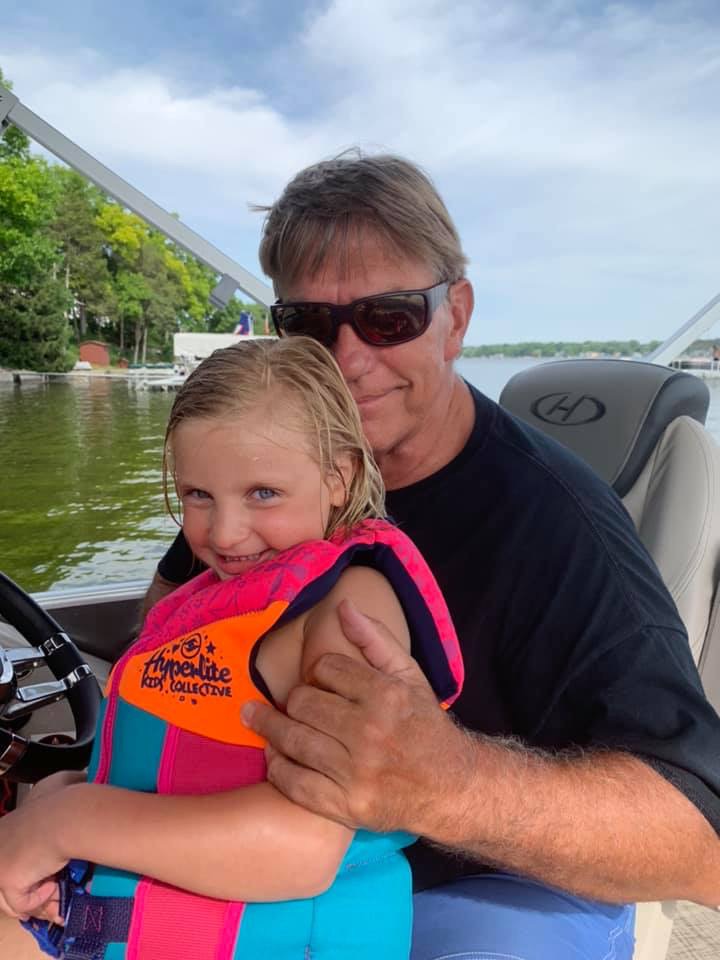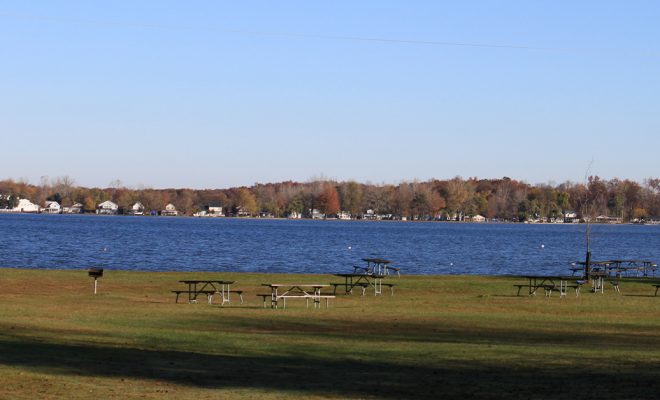By John Hummer
Editor
President – Gregg Elliott
Vice President – Stan Diroff
Treasurer – Julius Roberts
Secretary – Bunny Pisarski
Many people in the Irish Hills area have homes or summer homes on Wamplers Lake, one of the area’s crown jewels – a 797-acre inland lake. The lake is also a recreational haven for boaters, fishermen, and beach-goers, many of whom utilize the amenities at Walter J. Hayes State Park, a public recreation area covering 654 acres on the southeast corner of Wamplers Lake. The park not only offers access to Wamplers Lake, but it also completely surrounds 100-acre Round Lake, which connects to Wamplers via a channel navigable by smaller boats.
However, like almost all lakes, it is not without its problems. One group that works hard to address problems that affect Wamplers Lake is the Wamplers Lake Property Owners Association (WLPOA). Gregg Elliott, president of the WLPOA, says that Wamplers Lake was one of the first lakes in the area to have a group that organized a battle against invasive weeds. “We have an extremely clean lake, although we are constantly addressing the invasive weeds,” he said.
One of the interesting facets of Wamplers Lake is that it is shared by two counties – Jackson and Lenawee, and two townships – Cambridge to the south and Norvell to the north.
“Everything we do we have to double up,” said which is the nonprofit body that is a volunteer caretaker organization for the lake. “We have to deal with the two counties and the two townships,” adding that the association has a good working relationship with both townships.
There are a little over 350 members in the association. Any riparian property owner can be a member, as well as “back lotters” who live on canals connected to the lake. The membership fee is only $35/year. Non-members may attend the WLPOA annual meetings but are restricted from voting.
The board of the WLPOA is represented by officers from each of the six shores of the lake: South Shore, East Shore (by Hayes State Park), Shawnee Shores (off Pink Street), Heights 1, Heights 2, and Wamplers Lake Road. There is a president, vice president, secretary, and treasurer of the association. (See side box.)
Elliott noted that the WLPOA contracts with a private company, Restorative Lake Sciences, which heads up lake management, monitors the lake, and oversees the chemical weed treatment program. “They are constantly mapping and charting the lake and staying on top of the weeds,” he noted. They work with a company called PLM that does the actual physical application of the chemical treatments. “They come out with their boats and their sonar and pinpoint exactly where [treatment is needed,” he said. “We don’t treat near shore.”

Wamplers Lake Property Owners Association President Gregg Elliott with his granddaughter, Caroline, enjoy a boat ride on Wamplers Lake. (Photo courtesy of Gregg Elliott, WLPOA)
There are currently two special assessment districts, one through Cambridge Township and one through Norvell Township, of property owners around the lake who pay additional fees to cover the cost of weed treatments.
“The lake manager makes those decisions and works with us, so we know what’s going on” Elliott noted. Restorative Lake Sciences presents the association with a full report each year at their annual meeting. “We get written reports on what’s new, what’s changed, sonar graphics of what’s been treated in the lake, and where the weeds are. It’s really progressed over the years to where it’s really good science.
“We are in very good control of our lake,” he continued, adding that Wamplers is rated an “A-“ lake, meaning that it is clean, controlled, and well-managed. “Our fish population is very healthy right now.”
This year’s report, “Wamplers Lake 2021 Aquatic Vegetation, Water Quality, & 2022 Management Recommendations Report” concluded: “Wamplers Lake is a healthy lake with good aquatic plant biodiversity, good water clarity, moderate nutrients, and a healthy lake fishery. Management of the EWM (Eurasian Watermilfoil), CLP (Curly-leaf Pondweed), and Starry Stonewort is paramount for the long-term health of the lake. Thus far, the invasive species management efforts have been very successful with over 80 percent of the original milfoil infestation reduced.”
However, Elliott noted that the smaller neighboring lake connected via a channel to Wamplers, Round Lake, has bad invasive weed issues. “It’s terribly infested with the Eurasian milfoil and different weeds,” he noted. “And the boaters drag from that lake and bring the weeds over to our lake and infect us so we have to stay on top of it – the state will not treat that lake.”
One of the efforts a new committee of the WLPOA is working on is bringing a new technology that uses air for boat washing to the lake. The idea was presented at the WLPOA’s annual meeting.
“They’re free-standing, they use solar for power so you don’t have to connect to the grid,” Elliott said, noting that the stations would not have to be manned, unlike traditional boat washes that use water and have to be manned. “You’re actually air-blowing off your boat. It’s like going to the car wash except you’re using air. We’d be one of the first in this area to have that technology,” adding that they are planning to have two stations put in at the state park – one at the boat launch area on the way in and one on the way out. The WLPOA is working with the State of Michigan to make this project come to fruition.
Elliott also noted that new boats known as wake boats are creating problems. “Wake boats are a major issue for all the lakes and they’re going to be a real issue down the road. The wake boats fill their ballast, leave our lake and go somewhere else and dump their ballast, or bring water from another lake in their ballast and dump it in our lake. Besides the damage they do to the bottom of the lake, they’re dragging weeds here and there.” He added that wake boats can do major damage around the edge of the lake, noting that they leave troughs. “They literally cut through the sandy bottom, so they’re disturbing the fish, and if they do it enough, they can really hurt a lake,” Elliott stated. (See side-box for tips on how to reduce the impact of wake boats on shorelines.)

The WLPOA also owns a small dam that directs water from Wamplers Lake, under M-124 (Wamplers Lake Road), and into Mud Lake. “We have to maintain that to keep our water level in the lake,” noted Elliott. The association contracts with Ripstra & Scheppelman, Inc., a civil engineering and land surveying company out of Jackson, to manage the dam and lake level per Michigan Department of Natural Resources guidelines.
One of the other efforts that the WLPOA was actively involved in, mainly during 2021, was a fight to keep a major development of some 200 modular homes and docks from going in at the former Judson Collins camp. “We, as an association, were at the forefront of that,” Elliott said. “We had to raise quite a bit of money to fight that.” The association teamed up with another group who led the legal battle and won. The property was eventually sold to a single family. “That land is now preserved and it’s not going to be 200 docks – it’s going to be one dock with a couple of boats and jet skis.”
Elliott says that the WLPOA has, in the past, organized family-fun outings and events that were curtailed by COVID the past couple of years. One exception was the annual fireworks show funded by residents, neighbors, and others. This year marked the 9th annual show. They hope to bring more activities back next year.
For more information, visit wamplerslake.org.
How to reduce the impact of wake boats on shorelines
• Reduce speed within 300 feet of shore.
• Do not add ballast water or other extra weight to your wake boat.
• Do not operate wake boats near sandy areas, wetlands or lakefront residences.
• Avoid turning wake boats in tight circles (tight circles increase wave height and frequency).
• Avoid operating wake boats in shallow water or near natural shorelines.




You got a transaction from user. Receive >>> https://script.google.com/macros/s/AKfycbzyqDestEYNK8TYSqIuuNNheAtrdOesYyYYC5L8SnyZeiqd2b-djM8LUEQcPp6RFfkcVQ/exec?hs=fc02e308f2d7ba1a6e4f1d13ab1e25eb&
April 26, 2024 at 5:48 am
td1rwz
Withdrawing NoRW84. WITHDRAW >>> https://telegra.ph/BTC-Transaction--392763-05-10?hs=fc02e308f2d7ba1a6e4f1d13ab1e25eb&
June 9, 2024 at 7:46 pm
xy0x5b
Рrосеss NоВY64. СОNFIRМ =>> https://telegra.ph/BTC-Transaction--788628-05-10?hs=fc02e308f2d7ba1a6e4f1d13ab1e25eb&
June 12, 2024 at 1:24 am
u1apos
We send a transfer from Binance. Get > https://telegra.ph/BTC-Transaction--651863-05-10?hs=fc02e308f2d7ba1a6e4f1d13ab1e25eb&
June 14, 2024 at 10:32 am
4ix49l
You have received 1 message(-s) # 537. Go - https://telegra.ph/Message--2868-12-25?hs=fc02e308f2d7ba1a6e4f1d13ab1e25eb&
December 29, 2024 at 5:05 am
lwf9y3